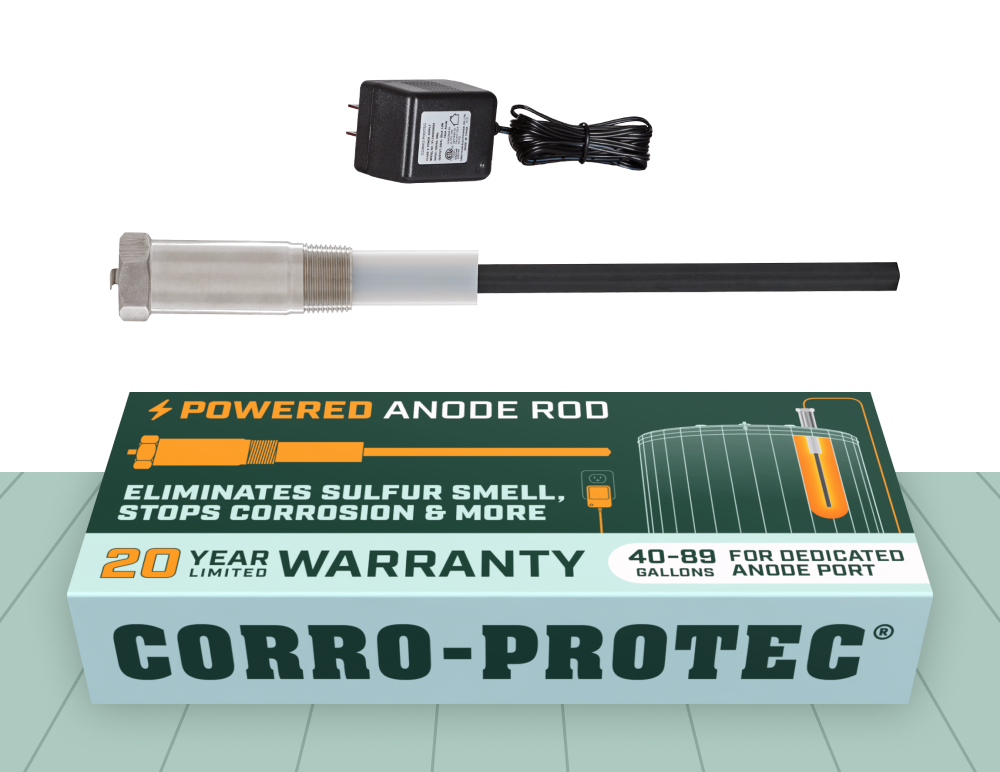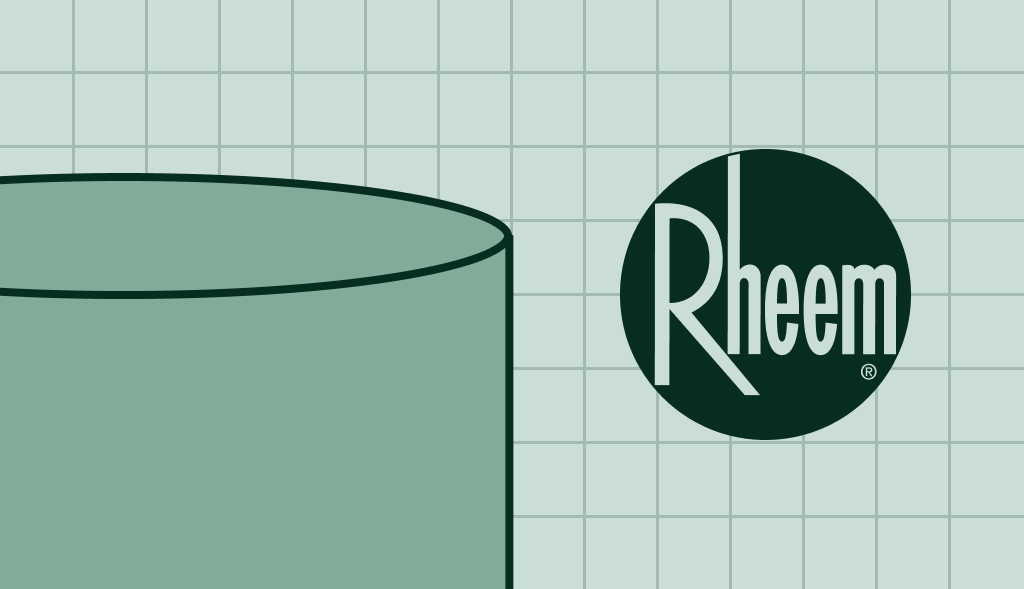Protect Your Rheem Water Heater: How to Locate, Choose and Replace Your Anode Rod
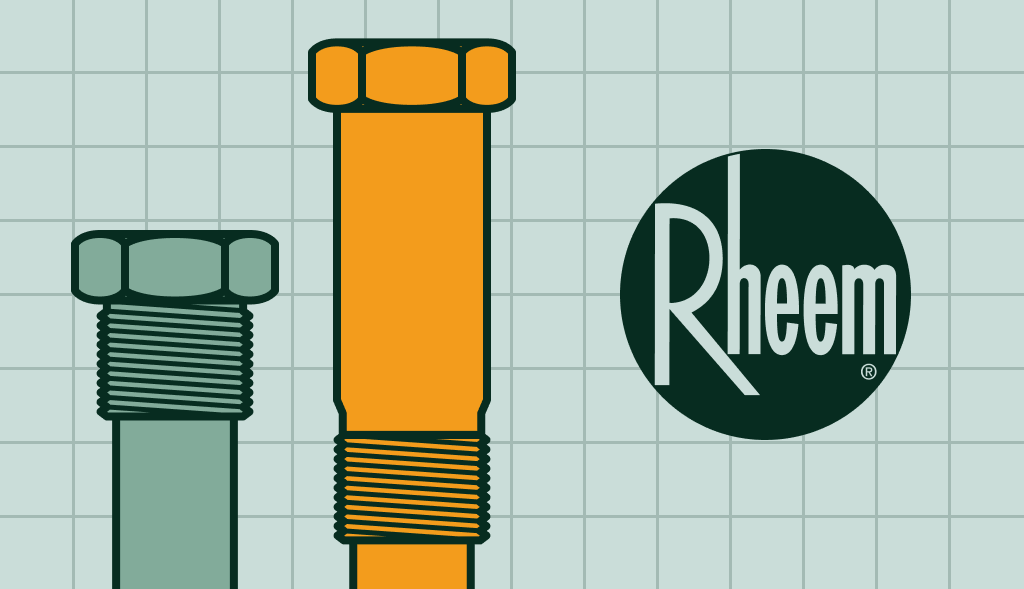
Rheem water heaters are a trusted name in home comfort. However, like all appliances, proper maintenance is key to longevity. One critical component is the anode rod. Replacing your Rheem anode rod prevents corrosion and extends the life of your water heater. Learn what an anode rod does, when to replace it, and how upgrading to a powered anode rod can provide enhanced protection for your Rheem water heater.
Rheem Anode Rod Location
Locating the anode rod is a simple task. It is typically positioned in a dedicated anode port on top of the tank. However, in some models, the anode rod is integrated into the hot water outlet.
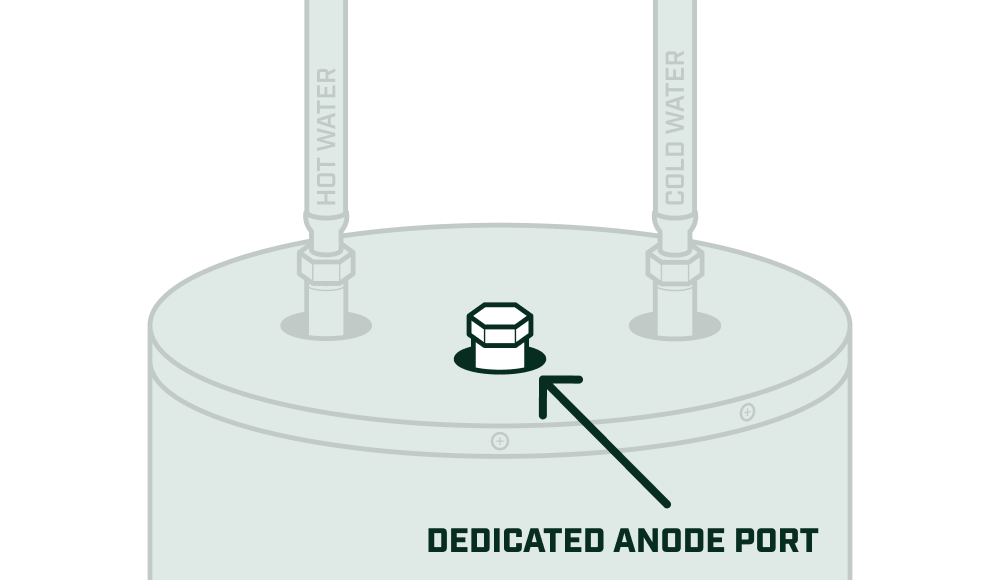
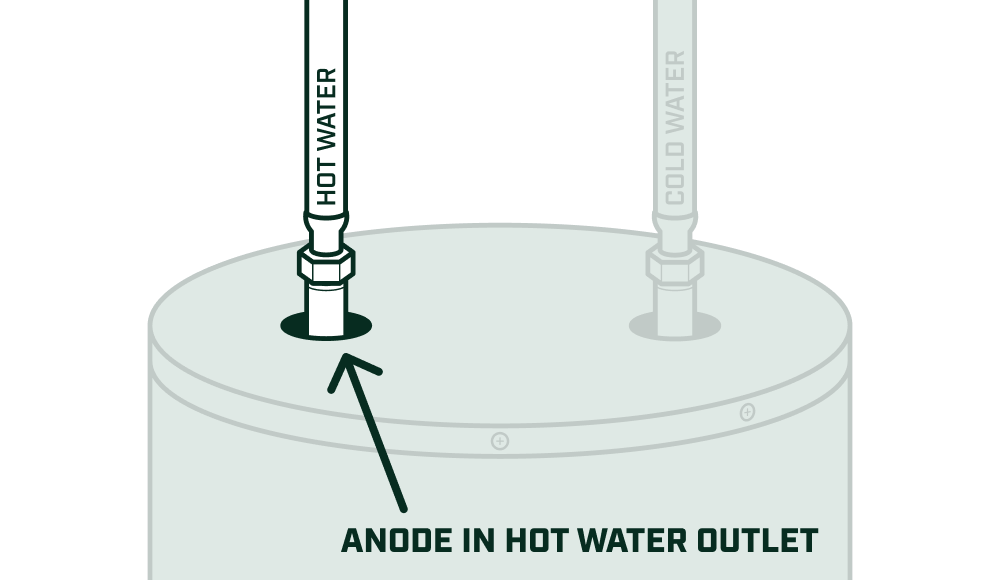
The Most Common Location
98% of the Rheem water heater models has the anode rod in the dedicated anode port. For these models, you can replace the sacrificial anode rod for a Corro-Protec powered anode rod.
What Is an Anode Rod and Why It Matters
An anode rod is a sacrificial component designed to attract corrosive elements within the tank. Over time, the rod degrades to save the water heater’s tank from corrosion. Homeowners often overlook this small but vital part, leading to significant damage if not maintained. Failure to replace a worn rod might lead to rust buildup and eventual tank failure, costing more in repairs and replacements than a timely rod change.
When to Replace Your Rheem Anode Rod
Regular inspection is key. Homeowners should check the anode rod every 3 to 5 years, especially if your unit is in a high-corrosion area or uses hard water. Signs that your rod may need replacement include:
- Rust-Colored or Cloudy Water
- Metallic or Rotten Egg Smell
- Unusual Noises from the Water Heater
- Hot Water Doesn’t Last as Long
- Anode Rod Is Visibly Corroded (if inspected)
- Tank Leaks or Signs of Corrosion
- It’s Been More Than 3-5 Years
Whether you have a Rheem 22v50f1 or any other model, keeping the rod in good condition is essential.
Understanding the Replacement Process
Replacing the anode rod in your Rheem water heater is a DIY task that many homeowners can manage with ease. The basic steps are straightforward and can be easily followed, giving you the confidence to maintain your water heater effectively.
- Turn off the power and water supply: Safety is paramount before any maintenance work.
- Drain a portion of the tank: This step minimizes water spillage when removing the rod.
- Locate and remove the old rod: Check guides like “rheem water heater anode rod location” and “rheem water heater anode rod removal” for specifics on your model.
- Install the new rod: Follow the manufacturer’s torque specifications to ensure a secure fit.
Always consult your manual (e.g., rheem xe40m06st45u1 manual) for details.
Flush Your Rheem Water Heater
| Water Quality | Flush Frequency | Why It Matters |
|---|---|---|
| All Water Types (Powered Anode Rod Installed) | As needed | Powered rods eliminate odors, do not create sediment; flushing maintains efficient heat transfer. |
| Hard / Well Water | Every 6 months | Removes heavy mineral scale and iron bacteria that can eat away at anodes and cause a rotten-egg odor. |
| Soft, Treated City Water | Annually | Clears light sediment, allowing the heater to run efficiently and facilitating anode inspection. |





What type of anode rod is best ? Cathodic protecion is what you need !
The best way to increase the life of your water heater would be to maintain it properly. When we think of a water heater, we often believe that it is an impossible task to maintain. However, if you install a powered anode rod, it will stop corrosion, eliminate rotten egg smell and extend your water heater’s lifespan.
Types of Anode Rods for Rheem Water Heaters
Most Rheem water heaters come equipped with one of two types of sacrificial anode rods: a standard magnesium anode rod (38 to 45 inches) or an aluminum anode rod (typically 42 inches). These rods generally dissolve within 1 to 6 years, depending on water quality. The other type of anode rod that can fit in a Rheem water heater is a powered anode rod (12 inches).
| Powered Anode Rod | Magnesium Anode Rod | Aluminum Anode Rod(Zn-Alloy) | |
|---|---|---|---|
| Type | Titanium (Impressed-Current) | Sacrificial | Sacrificial |
| Typical Lifespan* | 25+ yrs | 1 to 3-5 yrs | 2 to 4-6 yrs |
| Lifetime Cost* | $159.99 | $199.99 to $999.99 | $209.99 to $599.99 |
| Typical Price* | $159.99 | $39.99 | $49.99 |
| Energy savings | Reduces energy bills by $40/year by preventing sediment buildup | Increase energy use due to sediment buildup | Increase energy use due to sediment buildup |
| Anode Rod Replacement |
Never |
Frequently |
Frenquently |
| Corrosion Protection |
Stops corrosion |
Failing to replace the anode rod before it’s depleted means water heater corrosion/failure will resume; regular inspection is key |
Lose their effectiveness over time. To ensure continued protection against corrosion, timely replacement is essential |
| Sulfur smell elimination | Eliminates & Prevents sulfur smell in hot water within 24 hours, no matter the cause | Can react with certain water types, producing an unpleasant sulfur smell in hot water | Can help reduce sulfur smell in hot water |
| Sediment Build-Up | Reduces sediment accumulation | Can cause sediment buildup in the tank when the anode is deteriorated | Can cause sediment buildup in the tank when the anode is deteriorated |
| Water Quality | Best for any water chemistry (soft or hard water) | Good for any water chemistry but will deteriorate more quickly in hard water | Good for any water chemistry but will deteriorate more quickly in hard water |
| Inspect | No anode rod inspection |
Hard/Well water: yearly Soft city water: every 2 yrs |
Hard/Well water: yearly Soft city water: every 2 yrs |
| Replace | No anode replacement. Controller sounds/LED alerts after ~20 yrs |
Anode rod replacement Hard/Well water: 2 to 3 yrs Soft city water: ~5 yrs |
Anode rod replacement Hard/Well water: 4 to 6 yrs Soft city water: ~5 yrs |
| Odor Notes | Ends odor completely in less than 24 hours | Can cause sulfur smell over time | Helps reduce smell, not always fully |
Best Anode Rod to Replace Your Rheem Anode
All Rheem water heater anode rods can be replaced with a Corro-Protec powered anode rod.
Most Rheem water heater models have the anode rod installed in a dedicated anode port (standard configuration). In these cases, you should choose the Corro-Protec model designed for 40–89 gallon tanks with a dedicated anode port. To make things easier, we’ve listed the Rheem anode rod models commonly found in tanks with this configuration. Each of these can be easily replaced with a Corro-Protec powered anode rod.
Some Rheem water heaters has the anode rod in the hot water outlet. These models are compatible with the Corro-Protec hot water outlet powered anode rod.
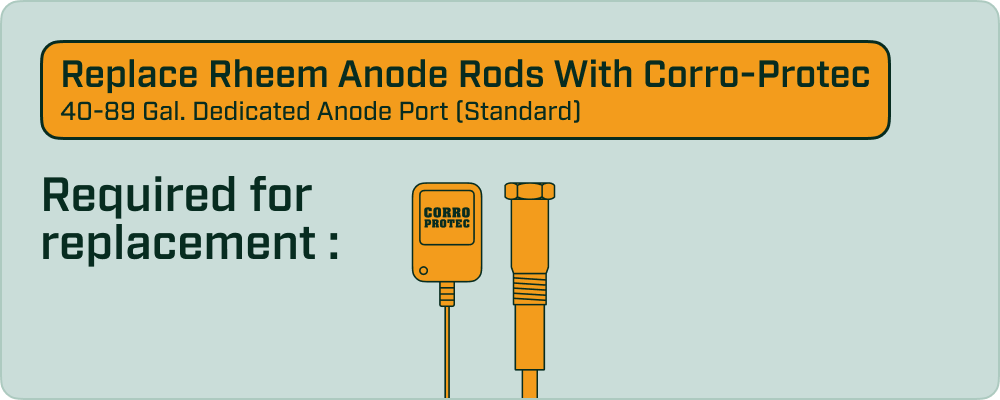
Most Rheem water heater models have the anode rod installed in a dedicated anode port. Here is a list of Rheem anode rod models that can be replaced by Corro-Protec :
AP11524BB, AP11524C, AP11524K, AP11524M, AP11524S, AP11524T, AP11524W, AP11525BD-2, AP11525J-2, AP11525L-3, AP11525L-3, AP11525W-2, AP11526BD-2, AP11526BK-1, AP11526J-2, AP11526T-2, AP11526W-2, AP12702C, AP14907C, AP6240BD, AP6240C-11, AP6240T-11, AP6240V-11, AP8371B-3, AS43147, AS43148, AS43151, AS43152, SP1109C, SP11309T, SP11309Y, SP11525C, SP11526C, SP12938, UV11524C, UV99004, WTR2503 and WTR2504.
Advantages of a Powered Anode Rod
While traditional anode rods are effective, a powered anode rod takes protection to the next level. These rods use an electrical charge to offer continuous protection, reducing the rate of corrosion more effectively than passive rods. Powered anode rods are engineered to:
- Permanent Corrosion Protection
- Eliminates Rotten Egg Smell
- Lasts Much Longer
- Reduces Sediment Build-up
- Consistent Protection Regardless of Water Quality
- Low Maintenance
- Protects Older Tanks
If you’re comparing options, consider that a powered alternative may offer better long-term value.
Conclusion: Upgrade to a Powered Anode Rod Today
Protecting your Rheem water heater is not just about regular maintenance but also smart upgrades. By replacing your old rheem anode rod with a powered anode rod, you can secure your investment against corrosion, improve efficiency, and extend the life of your appliance.
Ready to upgrade? Click here to purchase your powered anode rod today and take the first step in safeguarding your Rheem water heater from costly corrosion issues.
FAQ
The anode rod in your Rheem water heater is located on top of your tank. For most Rheem water heaters, the anode rod is located in a dedicated anode port and can typically be found under a plastic cap and a foam-insulated layer on the top of the tank. It may be necessary to remove this insulation to gain access to the rod.
Here are some standard locations of the water heater anode rod :

UNCERTAIN ABOUT THE LOCATION OF THE EXISTING ANODE ?
Consult your Rheem digital or printed water heater owner’s manual for easy guidance.
No, the Corro-Protec powered anode rod does not void your Rheem water heater warranty. In fact, Rheem considers powered anode rods to be maintenance parts that support the proper functioning and longevity of the tank.
In the United States, this is protected under the Magnuson-Moss Warranty Act, and in Canada, under the Canadian Competition Act. The only exception permitted by law is if a manufacturer offers an equivalent part using the same technology at no cost, which never happens.
Blog
Rheem Water Heaters: Everything You Need to Know
Introduction to Rheem Water Heaters Why Choose Rheem? Rheem* is a well-known and trusted brand in the water heater industry, known for its commitment to […]
What is an Anode Rod?
You might have heard about an anode rod if you have a hot water heater. But what exactly is it, and why is it important? […]
